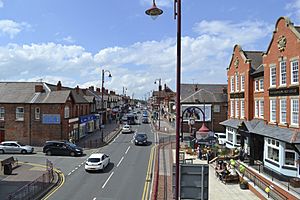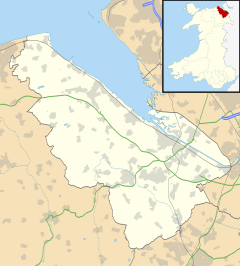Shotton, Flintshire facts for kids
Quick facts for kids Shotton |
|
|---|---|
| Town and community | |
 A view from the railway bridge, showing Chester Road |
|
| Population | 6,663 (2011 census) |
| OS grid reference | SJ305685 |
| Principal area | |
| Ceremonial county | |
| Country | Wales |
| Sovereign state | United Kingdom |
| Post town | DEESIDE |
| Postcode district | CH5 |
| Dialling code | 01244 |
| Police | North Wales |
| Fire | North Wales |
| Ambulance | Welsh |
| EU Parliament | Wales |
| UK Parliament |
|
| Welsh Assembly |
|
| Website | Town council website |
Shotton is a town located in Flintshire, Wales. It is part of the Deeside area, which is a group of towns along the River Dee. Shotton is very close to the border with England.
The town is connected to Connah's Quay and is about 5 miles (8 km) west of Chester. You can get there by car using the A548. In 2011, about 6,663 people lived in Shotton.
Contents
What Does Shotton Mean?
The name of Shotton has an interesting history. It was first written down in Old English as Cyllingas. This name comes from the Welsh word Celyn, which means Holly. This older name has stayed around in different forms.
For example, in 1822, someone named Richard Willett wrote about the name Kyllins. He said it was linked to one of the oldest houses in the area. Even today, you can find Killin's Farm and Killin's Lane in the oldest parts of Shotton.
The modern English name Shotton is also used for three other towns in Britain. These towns are near the Scottish border and their names mean "Town of Scots". However, it's not likely that the Shotton in Flintshire got its name this way.
Instead, the name probably comes from two Old English words:
- Scēot-tūn, meaning "farmstead on or near a steep slope".
- Shot-tūn, meaning "farmstead in a clearing in the wood".
Shotton is special because it's one of the few towns in Wales that has the same official name in both English and Welsh. It also doesn't have a known Welsh meaning for its modern name.
Shotton's Past
Shotton started to grow in the 1700s. It became important because of coal mining and farming. People also worked on reclaiming marshland to make it useful.
The town also became a place where different railway lines met. A very important part of Shotton's history is the John Summers & Sons steelworks. This large factory started in 1896. At its busiest time, it employed over 13,000 people!
Later, in 1967, the steelworks became part of a bigger company called British Steel Corporation. Even though it's called Shotton Steel Works, most of the plant is actually across the river in the community of Connah's Quay. Since 2006, this big factory has been owned by Tata Steel.
Another important landmark is the Hawarden Bridge. This bridge was finished in 1889. It used to be able to swing open to let ships pass, but this feature was stopped in 1960.
Who Lives in Shotton?
Shotton covers an area of about 2.34 square kilometers. This means it has a population density of about 3,001 people per square kilometer. The number of males and females living in Shotton is almost equal. About 62.2% of the people are between 18 and 64 years old.
The community of Shotton is divided into three areas called electoral wards. These wards are used for local elections for the Flintshire County Council.
| Ward | 2001 Census | 2011 Census |
|---|---|---|
| Shotton East | 1,803 | 1,958 |
| Shotton Higher | 2,529 | 2,576 |
| Shotton West | 1,933 | 2,129 |
| Shotton Total | 6,265 | 6,663 |
Schools in Shotton
Shotton has several schools for children of different ages:
- Connah's Quay High School (a secondary school where lessons are taught in English)
- Hawarden High School (another English-medium secondary school)
- St Ethelwold's Primary School (a primary school connected to the Church in Wales)
- Venerable Edward Morgan School (a Roman Catholic primary school)
- Ysgol Ty Ffynnon (an English-medium primary school)
- Ysgol Croes Atti (a primary school where lessons are taught in Welsh)
- Ysgol Maes Garmon (a secondary school where lessons are taught in Welsh)
John Summers High School, which was once called Deeside High School, closed down on July 20, 2017.
Getting Around Shotton
Shotton railway station is an important transport hub. You can catch trains there on the Borderlands Line and the North Wales Coast Line.
Famous People from Shotton
Some notable people have connections to Shotton:
- Fred Robson (1885–1952) was a professional golfer who played in the Open Championship.
- Henry Weale (1897–1959) received the Victoria Cross, a very brave award, during World War I.
- Billy Tudor (1918–1965) was a footballer who played 87 games for clubs, mostly for Wrexham A.F.C..
- Marika Humphreys (born 1977) is an ice dance coach and choreographer who used to live in Shotton.
See also
 In Spanish: Shotton para niños
In Spanish: Shotton para niños


